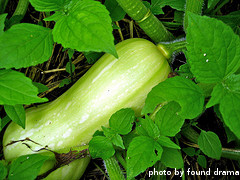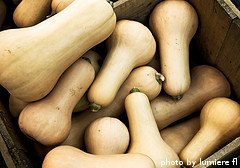Questions About Growing Butternut Squash?
You've come to the right place. Growing butternut squash has become a yearly tradition for many folks. That's probably because butternut squash are so easy to plant, maintain and harvest. They are also delicious to eat in a wide variety of recipes. The plants can get large and lush and feature attractive blossoms that attract bees and butterflies to your garden. In addition, if you have less space, there are now bush varieties available that can even be grown in containers.
When choosing a variety of butternut squash to grow, think about how much space you have and what you want to do with the squash after you harvest it. Some varieties store better than others. Some varieties have higher sugar content than others. Some produce more squash than others. For example, a bush variety might produce 5 squash that average 2 pounds each. After peeling and seeding them, you'll end up with around 8 pounds total of squash to eat/freeze. A large vining variety might produce 5 squash that average 10 pounds each, and after peeling and seeding them, you'll end up about 45 pounds of squash to eat/freeze. Do you want or need 45 pounds of butternut squash? Do you have the space to store that much squash? These are things to consider when choosing which butternut squash variety to grow.

We like to grow a couple of different butternut squash varieties in our garden every year. We always grow Rogosa Violina Gioia, which is an Italian heirloom variety with huge vines that matures in about 95 days. We also grow a faster-maturing bush variety, that is usually ready in 75 days. This way, we get to harvest and enjoy fresh butternut squash for several weeks, because as the bush variety is winding down, the vining variety is just ramping up.
A typical vining butternut squash plant will produce 5-15 squash, depending on the variety. Typically, a variety that produces smaller squash will produce more of them, while varieties that produce very large squash will only support a few fruit per plant. Bush varieties typically produce fewer numbers of smaller squash, but you have room to grow more plants, so you can easily make up the difference.
Butternut squash are planted in the late spring, after all danger of frost, when soil temps have warmed to at least 60 degrees F. They are typically harvested in the late summer, depending on your climate.
When planting butternut squash, it's best to sow the seeds directly into the soil where you want the plant to grow. Like other squash varieties, butternut squash transplants don't usually do well because they won't tolerate having their root systems disturbed. You'll need a spot that gets 6-8 hours of direct sunlight everyday. The soil should be well tilled until loose and airy to a depth of at least 8 inches. Since a typical butternut squash plant will produce several pounds of squash or more, the plant will need room to develop an expansive root system. They are also heavy feeders that thrive in nutrient-rich soil.
In our own garden, we plant our butternut squash seeds in mounds that are about 12 inches high and 3 feet across. This allows for good soil drainage and gives the roots plenty of room to spread out. In addition, it's a perfet chance for us to add some composted manure to our garden, which we combine with the soil when creating the mounds.
After harvesting, butternut squash can be stored for several months in a cool spot like a root cellar. They also can be cooked and the flesh stored in the freezer for up to a year. Butternut squash are quite versatile and they can be mashed, fried, steamed, roasted, boiled, baked, stuffed and used to make soups and stews.
Quick Overview of Growing Butternut Squash
Planting: Plant seeds 1 inch deep about 2 weeks after last expected frost when soil temps have warmed to at least 60 degrees F. Space plants 2-4 feet apart, depending on type (vining or bush).
Fertilizing: Use balanced formula and apply once during planting and again when blossoms appear.
Watering: Keep soil moist but not wet.
Harvesting: Pick squash when skin is hard and there's no green stripes on the fruit.
Recipes: When you're done growing butternut squash, you can mash, roast, fry, bake, boil, steam or even smoke it.
Click on the following links to learn more about growing butternut squash.
Click here to learn about planting butternut squash
Click here for information about watering and fertilizing butternut squash plants
Click here to learn about harvesting butternut squash

Click here for help diagnosing and curing butternut squash plant problems
Click here for information about different butternut squash varieties
Click here for some of our favorite butternut squash recipes
Click here to move from our Growing Butternut Squash main page to our Home page